Understanding Rural Canada: Structures and Trends
Dr. Ivan P. Fellegi
Chief Statistician of Canada
September, 1996
 View the most recent version.
View the most recent version.
Archived Content
Information identified as archived is provided for reference, research or recordkeeping purposes. It is not subject to the Government of Canada Web Standards and has not been altered or updated since it was archived. Please "contact us" to request a format other than those available.

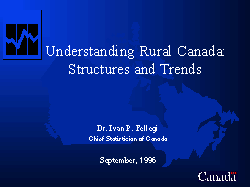
Slide 1
Good afternoon
It is a pleasure and a challenge to highlight some of the key structures and trends in rural Canada.
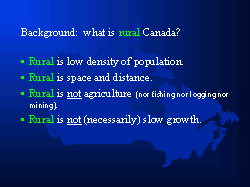
Slide 2
Low population density is one measure of how rural an area is. Another measure is the distance or remoteness of a population centre from another population centre.
Rural society was traditionally involved in primary production such as farming, fishing, logging or mining. Today, regardless of how 'rural' the region, only a minority of employment is involved in primary production.
Many rural areas have experienced long-standing out-migration. However, not all rural regions show slow growth.

Slide 3
I shall highlight some basic population data for Canada:
- presenting a focus on youth
- taking a look at various aspects of employment, and
- taking a look at some important outcomes of social and economic activities across Canada.
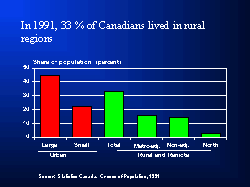
Slide 4
In 1991, 33% of Canadians lived in rural regions. This amounts to 9 million Canadians. There was an increase of 0.5 million people in rural areas between 1981and 1991.
However, the rural growth rate was less than the urban growth rate. Thus, the share of the population living in rural regions fell from 35% to 33%.
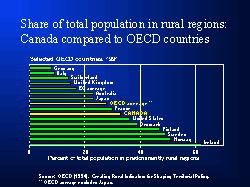
Slide 5
Among OECD countries, the share of Canada's population in rural regions is typical -- Canada ranks in the middle of OECD countries.
(Note: we did not graph all the OECD countries because of space considerations. Countries excluded: Belgium, Spain, Portugal, Iceland, Austria, Greece, Turkey.)
(Also note: The OECD average excludes Japan because the Japanese data are based on a different definition of "rural".)
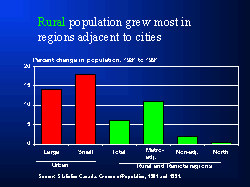
Slide 6
Population in rural regions grew 6% between 1981 and 1991. Population growth among rural regions was highest for those rural regions adjacent to metropolitan centers (11%). However, rural regions that are not adjacent to metropolitan centers grew only 2%.
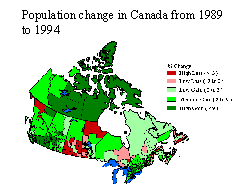
Slide 7
Population changes as a result of natural increase (births minus deaths) and net migration. Net migration is the sum of the movements:
- in and out of the country (international migration);
- in and out of a province (interprovincial migration), and;
- within a province (intraprovincial migration).
Since natural increase is stable, population change is determined generally by the extent and the direction (in or out) of the migration.
The average annual growth of the Canadian population between 1989 and 1994 was 380,000 or 1.3% of the population. Natural increase accounted for 53% of the total growth and the net migration, for the remaining 47%.
- Average annual growth during that period ranged from 2.7% (B.C.) to -0.1% (Sask);
- Natural increase as a % of population was highest in Alberta and the two territories;
- Immigration contributes to population growth in Que., Ont. and BC;
- BC also grows from net interprovincial migration, all other provinces and territories have negligible or negative net interprovincial migration.
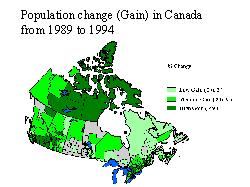
Slide 8
The fastest growing regions of Canada are in southern BC: in the outlying areas of Vancouver and Victoria as well as in the Okanagon Valley.
British Columbia's ratio of net migration far surpasses that of natural increase. This province enjoys high levels of both international and interprovincial migration. Immigrants, largely from the Pacific Rim, arrive in Vancouver and its neighbouring counties. Vancouver and Victoria in turn lose many of their residents to the outlying areas up to and including the Okanagan Valley. Interprovincial migrants settle in all regions of the province.
Population growth in the Yukon and the Northwest Territories is due almost solely to natural increase. Fertility levels are significantly higher than in other parts of the country and interprovincial migration flows are southbound.
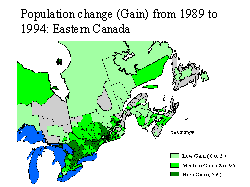
Slide 9
The counties of York, Peel and Simcoe (just north of Toronto) and Prescott-Russell (just east of Ottawa) have the highest growth rates of Ontario. Near Toronto, international and intraprovincial migration play strong roles in determining this high growth, whereas in Prescott-Russell all three levels of migration contribute.
Northern Montreal is also growing rapidly. Les Pays d'en Haut in the Laurentians and the suburb communities of L'Assomption, Mirabel and St Therèse de Blainville (where GM has an auto plant) are benefitting from movements from within the province of Québec. The impact of international and interprovincial migration for these areas is negligible.
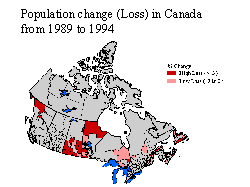
Slide 10
The region with the highest population loss is an outlier in northern British Columbia. Stikine, with a population of about 2,000 occupies a large territory in the northwest corner of the province. The decline in population is attributed to the closure of an asbestos mine.
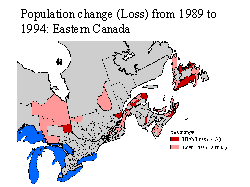
Slide 11
About one in five census divisions of Canada lost population between 1989 and 1994. These regions are concentrated in the Atlantic provinces, the southern shore of the St. Lawrence River in Quebec, and the small communities of Manitoba and Saskatchewan. With the exception of Saskatchewan and Sunbury, New Brunswick, the areas most affected lose more people to larger centres within their province than to other provinces and territories.
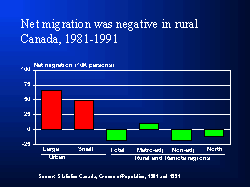
Slide 12
Migration includes immigration, emigration and movement within Canada.
Overall, rural regions lost population due to net migration.
That is, rural regions gained population because births minus deaths were greater than net migration. However, overall, rural people were voting with their feet to leave rural Canada.
Rural areas adjacent to cities gained population due to in-migration but rural areas non-adjacent to cities lost population due to out-migration.
(See Rural Canada: a Profile; Table 5 for details)
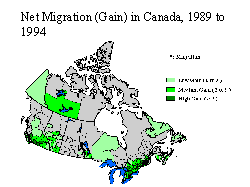
Slide 13
Positive net migration (i.e. net in-migration) is one of the factors causing strong population growth:
- in Vancouver and the lower mainland;
- in the Muskokas; and
- in the Laurentians
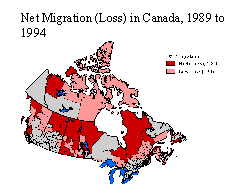
Slide 14
Negative net migration (i.e. net out-migration) is one of the factors causing strong population decline (or sometimes dampening population growth):
- in all of Saskachewan and western Manitoba;
- in the Prairie north;
- part of northern Ontario;
- northern Quebec and the lower S-Lawrence
- northern New Brunswick
- the ends of Prince Edward Island and Nova Scotia, including Cape Breton Island;
- outport Newfoundland.
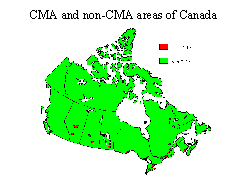
Slide 15
For the remainder of this presentation, we will be using statistics based on the CMA/non-CMA definition of the Canada's population.
A CMA (census metropolitan area) is an urban core of 100,000+ population plus CSDs (census sub-divisions; i.e. townships or municipalities) where 50+% of the labor force commutes into the urban core.
There are twenty five CMAs in Canada containing 61 percent of the population of Canada.
Note that fully one-third of Canadians living in centres with less than 1,000 people are living within CMAs. These individuals might otherwise be classified as "rural" but we classify them within the CMA.

Slide 16
One recurring theme among rural families and rural development practitioners is the so-called exodus of rural youth. The next series of graphs focuses on rural youth.
Rural youth outmigration is a continuing problem for rural development initiatives. Moving in search of a job has traditionally depleted the human capital complement in rural areas. The decline in job growth in urbanized regions has re-emphasized attention to rural youth retention as a rural development strategy. Mobility from rural to urban for individuals 20 to 24 years of age is high.
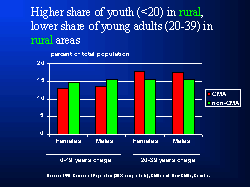
Slide 17
This population graph compares the share of population within each age group for CMAs (census metropolitan areas) and non-CMAs where a CMA is a center with a population of 100,000 or more plus all surrounding municipalities where 50% or more of the workforce commutes into the urban core.
Note that the non-CMA population has a higher share of young persons under 20 years of age and a much lower share of people in the 20 to 39 age group. These are the youth that have "gone down the road" to the city.
What are some characteristics of these youth?
Source: 1991 Census of Population (20% sample data), CMAs and Non-CMAs, Canada.
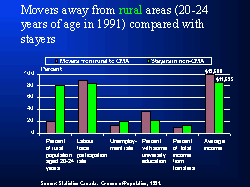
Slide 18
Between 1986 and 1991, 19 percent of rural (i.e. non-CMA) youth moved from rural to urban. Those who moved had a higher labour force participation rate (89 percent), lower unemployment rate (13 percent), a higher share were attending school (33 percent), a high share had some university education (37 percent) and their incomes were higher.
Thus, from these statistics, it appears that rural areas are losing their best and brightest youth.
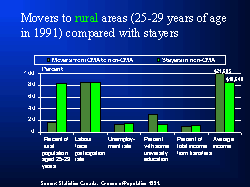
Slide 19
However, if we look at the next age group, we see in 1991, 16 percent of rural individuals aged 25-29 had moved from an urban (i.e. CMA) area in the previous five years. This somewhat compensates for the larger out-migration of the younger group. Note that urban youth moving to rural areas also have:
- high labor force participation rates;
- lower unemployment rates;
- a higher share with university education; and
- higher incomes.
Thus, rural areas, in general, are able to attract well educated youth. Obviously, not all rural areas are equally attractive - at another time we could review maps of intensity of in-migration to analyse where a large share of these youth are moving to.
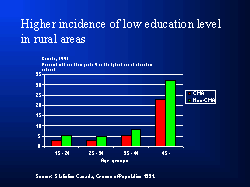
Slide 20
While rural youth are staying in school longer than their parents did, the percentage of youth who have grade 9 as the highest level of education is higher in rural areas than urban areas for all age groups.
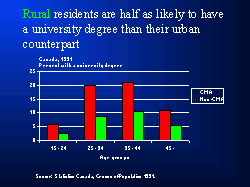
Slide 21
At any age, rural residents are half as likely to have a university degree than their urbancounterpart.
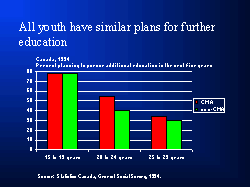
Slide 22
Future plans for education and training are equally important for both rural and urban youth.

Slide 23
The so-called electronic highway is expected to enable some entrepreneurial activity to develop in rural areas.
Although rural areas are behind in education levels, there is a strong base of computer literacy in rural areas upon which one might build rural development initiatives.
One indicator of the ability to use new technology is the share of individuals able to use a computer. In rural areas, a significant share, albeit lower than in urban areas, is able to use a computer in each age group.
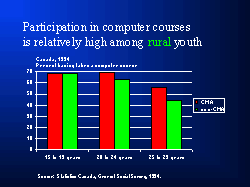
Slide 24
Training is a key component of "keeping up" and "getting ahead" with new technologies. Regarding computer related courses, again, in rural areas, a significant share in each age group, but a bit less than in urban areas, have taken computer courses.
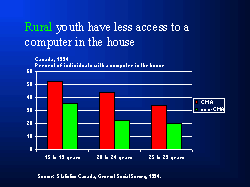
Slide 25
Previous graphs have shown rural youth have training and the ability to use computers. However, rural youth have less access to computers at their home.
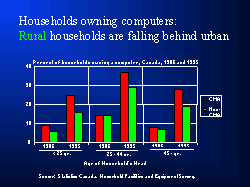
Slide 26
Between 1986 and 1995, the share of households owning computers increased in urban and rural areas. However, the increase was considerably larger in urban areas. Rural areas are falling behind in terms of the share of households with computers.

Slide 27
Although based on a small sample size, rural youth 15-19 years of age appear to be as likely as urban youth (15-19) to have used on-line services such as the Internet.
However, young rural residents 20 years and over appear to be only half as likely to have been "on-line".
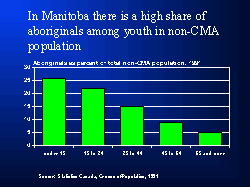
Slide 28
Aboriginal issues are both a rural and an urban issue. In both Manitoba and Saskatchewan, the share of population with an Aboriginal ethnic background will increase dramatically in the future. In Manitoba, Aboriginals represent one in twenty (5%) of rural individuals over 65 years of age and they represent one in four (26%) for individuals under 15 years of age.
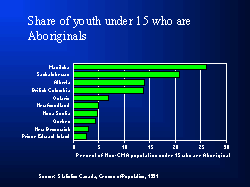
Slide 29
Manitoba and Saskatchewan show the highest share of rural youth being Aboriginal, followed by Alberta and British Columbia.

Slide 30
Next we will focus on issues related to employment.
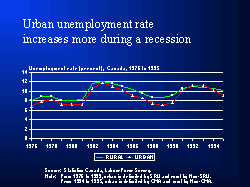
Slide 31
Going Down the Road to find a job in the city has always been part of life in rural Canada. Rural unemployment rates are above the urban rates at the Canada level and in all provinces except the Prairies.
During both the recession of the early 1980s and the recession of the early 1990s, urban unemployment rates increased relative to rural rates and in fact surpassed rural unemployment rates in 1992 and 1993. Thus, during a recession, the relative likelihood of finding a job in the city is just as bad as in a rural area.
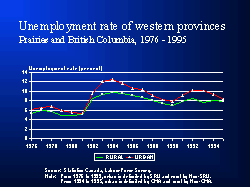
Slide 32
In the Western provinces, rural unemployment rate is generally lower than the urban one.
(We observe the reverse in the Eastern provinces - next slide).
The lower rural unemployment rate is explained, in part, by the larger concentration of farming activity in the Western rural regions. Farmers do not become unemployed even during the off-season because they are owner of a business. This is a Prairie phenomenom as the rural unemployment rate in British Columbia is generally higher than the urban one - like in the Eastern provinces.
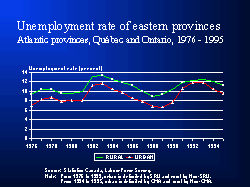
Slide 33
The rural economy in the Eastern provinces is more diversified than the Western one. (Farming accounts for a much smaller share of rural employment than in the Prairies.) Also, the rural economy in the Eastern provinces includes a greather percentage of paid workers in seasonal work such as fish processing, saw mills, etc. Partly due to these factors, the rural unemployment rate in the Eastern provinces is generally higher than the urban one.
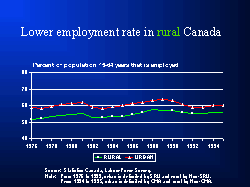
Slide 34
When we look at the rate of growth in employment by the degree of rurality of the region, we see a scatter of results. There is considerable diversity of employment growth rates within rural Canada. Some rural regions gained employment at a faster rate thatn urban regions. Thus, rurality per se is not a constraint on employment growth.

Slide 35
Next we take a quick look at the producerservices sector employment opportunities.
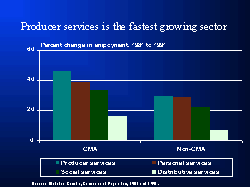
Slide 36
Producer services are growing the fastest.

Slide 37
Within producer services, it is business services that are growing the most. Business services include: employment agencies and personnel suppliers, computer and related services, accounting and bookkeeping, advertising, scientific and technical, lawyers and notaries, management consulting and other services intended primarily for businesses.
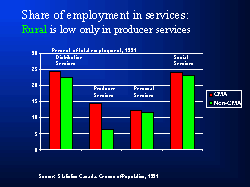
Slide 38
Note that the share of employment allocated to distributive services, personal services and social services is almost identical across urban and rural areas except rural areas have a much smaller share of their employment in producer services which means that they receive very little leverage from high growth rates in the producer services sector.

Slide 39
Small businesses play an important role in all areas of Canada. In the next set of slides, we review the distribution and change in employment among small, medium and large-sized businesses.
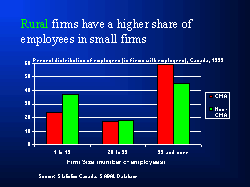
Slide 40
Rural areas are intensive in the small business sector. Rural areas have almost twice the share of their employees in small businesses, compared to urban businesses.
Note: This refers to employees in businesses with one or more paid employees.
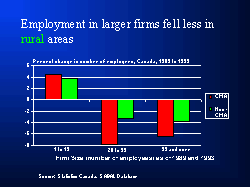
Slide 41
Growth of employment in the rural small business sector matched the growth in employment in urban small businesses. Note that the rate of job losses among larger business in rural areas is one-half the rate of job losses among larger businesses in urban areas.
Note: All firms in each period are classified to their firm size (number of employees) and the precent change in number of employees is calculated.
Also note that differences between SEPH and LFS account for some of the apparent disappearences of employees.

Slide 42
This topic considers the outcomes in terms of income levels.
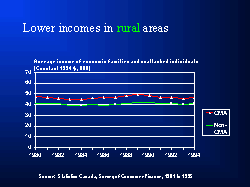
Slide 43
Average family incomes (in constant dollars) have been essentially flat throughout the 1980s and into the early 1990s.
Rural family incomes are lower and they have been equally flat.
Note: These findings hold for 2+ families and for unattached individuals
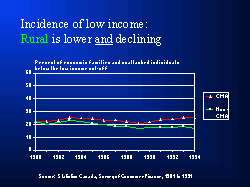
Slide 44
An alternate way to look at economic welfare is to consider the income distribution as indicated by the share of family units below Statistics Canada's low income cut-off. Note that the low income cut-offs are adjusted for family size and the urbanization class where the family resides.
Throughout the 1980s and the early 1990s, the share of urban and rural units with low incomes has been similar except we can see that the rural incidence of low incomes is somewhat lower and the rural incidence of low incomes is trending down (while the urban incidence has been increasing in recent years).
Note: These findings hold for 2+ families and for unattached individuals.
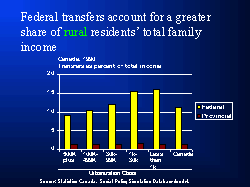
Slide 45
Federal tranfers account for a much larger share (16%) of rural residents' total income than of urban residents' total income at 9%. Much of the difference is accounted for by the unemployment insurance program, pensions to the elderly, and children's benefits (family allowances and the child tax credit).
Rural families have more children on average and lower average incomes.
Provincial transfer payments do not vary significantly by urbanization. These payments are largely made up of social assistance payments as well as some children's benefits.
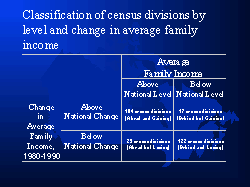
Slide 46
One way to see how the employment structure unfolds is to look at the level and the rate of change of family incomes.
In this table, the columns distinguish between census divisions with family incomes above the national average and census divisions with family incomes below the national average.
The rows distinguish between census divisions that are growing above the national average rate of growth and the census divisions that are growing below the national average rate of growth.
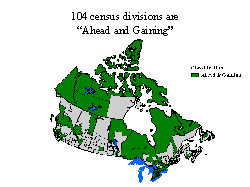
Slide 47
We see 104 census divisions have family incomes above the average and their rate of growth is also above the average. They are ahead and they are gaining.
Areas in Atlantic Canada that were "ahead and gaining" contained large regional centres such as St. John's, Halifax or were adjacent to centres such as Saint John.
The presence of northern Québec in this category can be explained in part by the increased construction activity associated with large hydroelectric projects. The Outaouais and suburban Montréal were also represented.Virtually all of Southern Ontario is part of this category - a testament to its well established affluence as well as its participation in the economic upswing in the late 1980s.
In Western Canada, these areas of relative economic advantage were clustered around major centres such as Winnipeg, Regina, Calgary and Vancouver. There were a few exceptions. The economy of northeastern Alberta, for example, was still benefitting from the development of the oil sands. Northern census divisions with mining, oil, hydro-electric construction or capital cities to boost family incomes are also in this classification.
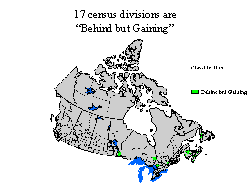
Slide 48
We see 17 census divisions that have average family incomes below the national average but rates of growth above the national average. They are behind but gaining. These few census divisions are somewhat peripheral (eg. eastern Manitoba, the Timiskaming region of Ontario, central New Brunswick, the two ends of PEI).
For several Atlantic census divisions categorized as "Behind but Gaining", strong employment growth was a factor in their relatively rapid increase in family incomes. The sources for this growth were diverse. In some areas manufacturing growth was strong. (Manufacturing employment in King's County, Nova Scotia grew by more than 50% (1200 jobs) during this period.) In others, there were healthy increases in producer services (Westmoreland County, New Brunswick experienced an increase of over 1200 jobs in this area.) In most of theses areas, there was also considerable job growth in social services such as education, health and public administration.
In Ontario, parts of "cottage country" are represented as greater resort development associated with the economic boom of the 1980s together with the desire of affluent urban dwellers "to get away form it all" helped to raise family incomes. As well, these areas have been increasingly successful in attracting the recently retired - many of whom have above average incomes.
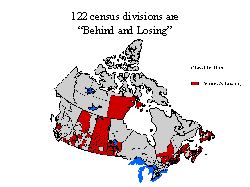
Slide 49
At the other end of the spectrum, we see 122 census divisions that have family incomes below the national average and the growth of family incomes is below the national average. They are behind and falling further behind. The concentration is:
- Agro-Saskachewan and agro-Manitoba - Traditional Wheat-growing areas suffered from drought, declining prices and increasing input costs during the 1980s.
- Most of rural Québec - essentially all regions east of Montréal to the Gaspé (excluding Québec City and adjacent areas)
- Many areas of chronic unemployment in Atlantic Canada, including Cape Breton Island and the coastal fishing communities of Newfoundland - note that these data predate the collapse of the cod fishery.
- Some northern areas with an increasing Aboriginal population and some B.C. regions not in close proximity to Vancouver and Victoria are also represented in this group.
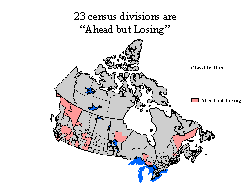
Slide 50
The final group is 23 census divisions with family incomes above average but income growth is below average. They are ahead but lagging.
A common theme underlies many of the rural areas classified as "ahead but losing" - the loss of high paying jobs in the primary sector. In Saguenay (Québec) and Algoma District (Ontario), there were significant job losses in the mining sector during the 1980s. In the Grande Prairie region of northern Alberta, there was a 50% decline in forestry employment. Job losses in mining, forestry and manufacturing were common in the British Columbia census divisions.
The relatively slow growth in family incomes elsewhere in Alberta can in part be explained by the slowdown in the oil and gas sector after its rapid expansion in the 1970s. Many construction and manufacturing jobs that were fueled by this expansion were subsequently lost.
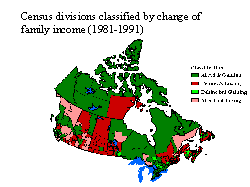
Slide 51
This composite shows the diversity of level and change of family income in Canada.

Slide 52
We next review some aspects of the quality of life in rural areas.
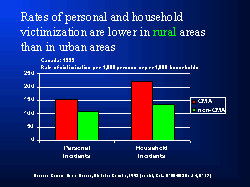
Slide 53
Personal incidents are crimes committed against an individual and include sexual assault, robbery, attempted robbery, assault, personal theft and attempted personal theft.
Household incidents include break and enter, attempted break and enter, theft of motor vehicles, vehicle parts or household property, attempted theft and vandalism.
Personal victimization is 30 percent less in rural areas. Household victimization is 40 percent less in rural areas. The difference in personal victimization is largely due to personal thefts and assaults being less in rural areas.
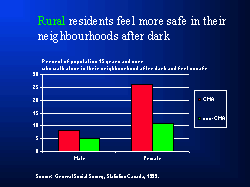
Slide 54
Rural residents are half as likely to feel unsafe when walking alone in their neighbourhoods after dark.
Fear of victimization is also demonstrated by the measures taken to protect oneself from being victimized.
During the twelve months prior to the 1993 General Social Survey, people living in rural areas were half as likely as urban residents to have installed new locks, installed a burglar alarm, taken a self-defence course and changed their telephone numbers to guard themselves against crime. Less than one-quarter of rural residents changed their routine or avoided certain places to keep from being victimized, compared to over one-third of urban dwellers.
(Source: Urban/Rural Criminal Victimization in Canada by Rebecca Kong, Juristat, Cat. No. 85-002 Vol.14, No 17)
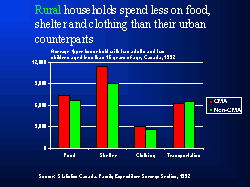
Slide 55
(Household of two adults and two children aged less than 16 years of age)This graph shows four categories of consumption expenditures: Food, shelter, clothing and transportation.
The average expenditures displayed are those of an household of two adults and two children aged less than 16 years of age in 1992.
These four categories of expenditures accounted on average for two-third of an household total expenditures which are on average 42,500$ in urban areas and 37,900$ in rural areas.
Note:Comparing average consumption expenditures of rural and urban households can be misleading. Although rural households spent less on average in total consumption expenditures than their urban counterparts, they also have lower average household income. Average household income after personal taxes were respectively in urban and in rural areas $49,$180 and $41,396 in 1992. If we substract their respective total consumption expenditures, rural households of two adults and two children below 16 years of age are left with $3,500 compared with $6,600 for urban residents.

Slide 56
Now, let's summarize by looking at a new typology for the Canadian population.
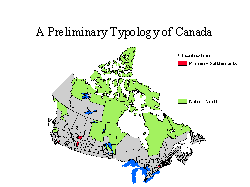
Slide 57
This typology was developed using 1981and 1991 Census of Population data to show the level of certain variables and their change over the 1981 and 1991 period. When we analyze these "outcomes" we can use the differences in their characteristics to define a new typology for the population of Canada.
There are substantial differences in measures of outcomes (eg. percent of population employed, levels of income, etc.) between the census divisions with large cities (labeled as 'primary settlements') and the rest of the census divisions.
Similarly, there are substantial differences in measures of outcomes between northern census divisions with a high proportion of Aboriginals in their population (labeled as 'native north') compared to the rest of the census divisions. The remaining census divisions were quite similar.
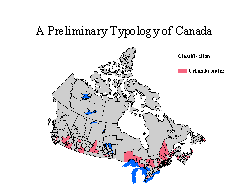
Slide 58
The remaining census divisions have relatively similar outcomes.
Although the relative differences are small, five classes can be seen.
Urban frontier: This is a group of census divisions with a larger city or adjacent to a metropolitan area with "outcome" characteristics similar to the primary settlements -- namely, higher incomes, higher educational levels, a skilled workforce and a service-based economy.
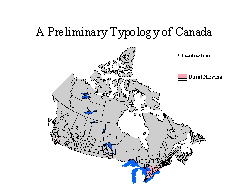
Slide 59
Rural nirvana: This is a group of census divisions that represent outmigration of citydwellers to the countryside. Skills and income levels are high. Residents are likely to commute to work and to remain economically and socially integrated to nearby cities.
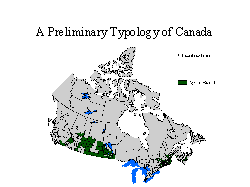
Slide 60
Agro-rural: This group of census divisions is characterized by rapid population decline, out-migration of the young, moderate income levels but a high degree of dependence on government services for employment and a relatively high dependency on government social transfer payments.
It is important to note that most of Saskatchewan and many Québec census divisions are within this type.
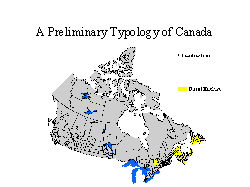
Slide 61
Rural enclave: This group of census Employment have few economic opportunities. Sectors that are present, such as manufacturing, fishing and forestry, tend to be in decline. The resulting outcome is low income levels, a high proportion of families below the low income cut-off and a high rate of dependency on government transfer income. Education levels tend to be below average and young people tend to stay within the area.
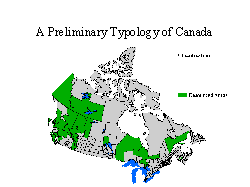
Slide 62
Resourced areas: This group of census divisions is dominated by mining and oil. There are young family structures, well educated, with high and stable levels of income.
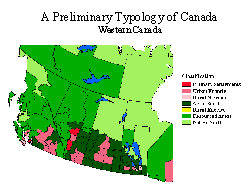
Slide 63
This is a composite map for the western provinces.
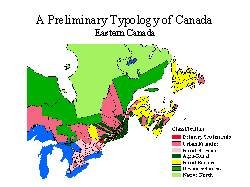
Slide 64
This is a composite map for the eastern provinces.
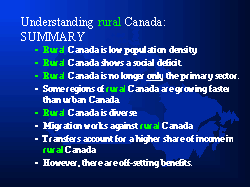
Slide 65
In sumary, .....

Slide 66
Thank You

last updated 1999/06/23
© Statistics Canada - Conditions of Use 

































































